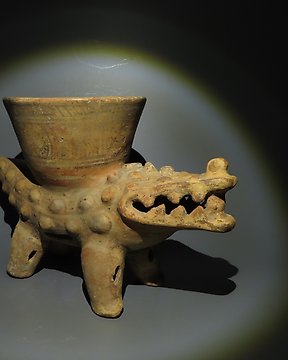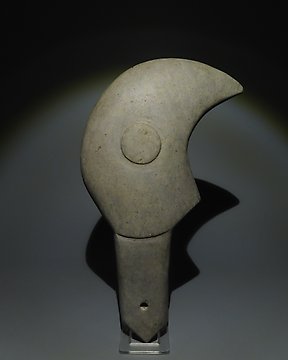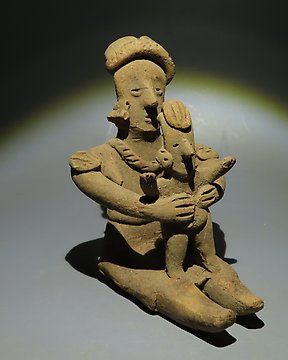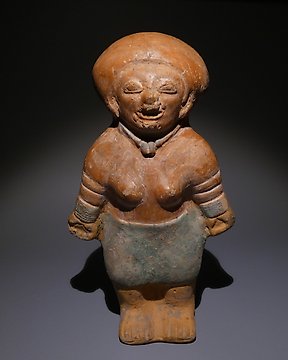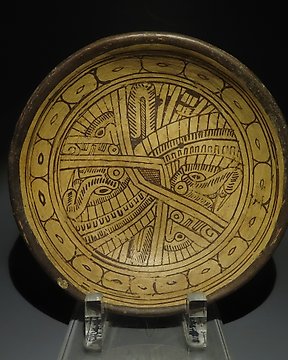
納亞里特州,阿茲塔特蘭,墨西哥西部。 Terracotta 漂亮的彩繪碗。西元 900 - 1200 年。 17 公分長。西班牙進口許可證。
Catawiki正在不斷更新其技術。 您目前正在使用過時的瀏覽器。 為了優化您的瀏覽體驗,請更新您的瀏覽器。
您可以使用以下切換按鈕設置Cookie偏好設定。您可以隨時更新您的偏好,撤銷同意,並在我們的Cookie政策中查看我們和我們的合作夥伴使用的Cookie類型詳情。
編號 83776887
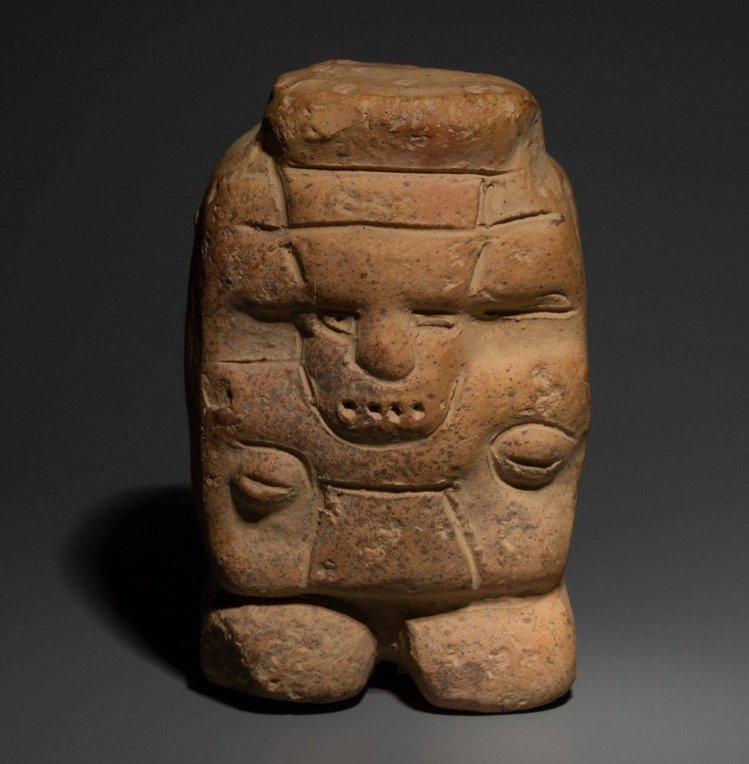


Figure.
Mayan, c. 600 - 900 AD.
Terracotta.
8.3 cm height.
PROVENANCE: Private collection of Charles Hopper (1949-2012), Chicago, Illinois, United States. Acquired in the 1980s; from there by inheritance. [Inv. nos. 43,44,56,58].
CONDITION: Good condition.
DESCRIPTION: The Maya civilization extended over a large area, from present-day south-central Mexico to Guatemala and Honduras. The area has three distinct geographic regions—the mountains and highlands, the tropical jungle lowlands, and the lowlands of the Gulf of Mexico and the Yucatan Peninsula—each with its own landscape and natural resources. During the Classical Period, the Mayans lived in the highlands and lowlands, in which Tikal and Kaminaljuyú were their major population centers, respectively.
The Mayan culture developed from earlier groups of village dwellers and farmers that lived the area and participated in the trade network. They also were influenced by groups living in what is now central Mexico, mainly the Olmecs. Around the 10th Century CE, lack of rain, ecological deterioration and social unrest resulted in the abandonment of the Mayan’s large urban centers. Later, groups of Mayan origin settled on the Yucatan Peninsula where they joined with other groups from central Mexico, mainly Toltecs, to build new civic and ceremonial centers such as Chichén Itza and Mayapán, which remained active until the arrival of the Spaniards in 1525. Today, the descendants of these ancient Mayans still live in the area that stretches from the Yucatán Peninsula to Honduras, where they continue their way of life, wear traditional clothing and speak the language handed down to them by this ancient American culture.
The Mayan economy was based on slash-and-burn agriculture. They grew their crops in fields called milpas, using pointed sticks for sowing maize, squash, chili peppers, beans and other crops. They worked the land four months of the year, rotating their crops to prevent erosion. They also collected a wide range of wild fruits and vegetables, hunted wild animals, extracted honey from beehives and fished in rivers, lakes and the sea. As each region had its own set of natural resources, exchange played a central role in Mayan economies. The Mayans measured time and the movement of the earth and heavens using a base 20 number system. They produced two calendars. One was the solar calendar or haab, which had 365 days broken into 18 months of 20 days each, plus an additional five days. This calendar was used to regulate non-religious activities. The lunar calendar, called tzolkin, had 260 days and was used for religious purposes. The two calendars were used simultaneously, represented together on a wheel. The wheel itself had a 52-year cycle, after which time events were expected to repeat themselves. The legacy of the Olmecs allowed the Mayans to develop a writing system based on signs or glyphs, written in two columns and read from left to right and top to bottom. This writing system is found on the walls and staircases of important Mayan buildings, on their ceramics, and in codices made of deerskin or amate bark paper.
The Mayans developed a unique artistic style with a degree of complexity that rivals that of European baroque. Their extremely life-like, anatomically proportionate human images are found in natural poses that emphasize movement. Their art represented sacred, ritual and hierarchical themes, although they also reproduced scenes from daily life and images of local fauna such as monkeys, tapirs, jaguars, bats, quetzal birds, fish and turtles. Stone was one of their favorite media, and they used it for their buildings, stelas, and the low- and high-relief sculptures that adorned their buildings. The Mayan’s architectural contributions include the stela-altar, the arch and the false vault. In addition to monumental art they also had a highly developed personal esthetic, manufacturing ear ornaments, pendants, necklaces, masks and other adornments out of jade. They deformed their craniums and noses and hung ornaments on their foreheads to make them squint-eyed.
They decorated their pottery with painted and engraved images, producing some of the finest works of pre-Columbian art. Popular Mayan ceramic pieces included serving bowls, pipes and vases, the last of these often adorned with Mayan glyphs.
Religion was a central aspect of Mayan culture. They believed in an earthly world and a supernatural one, an underworld and an overworld, viewing these as a single entity in which humans, deities, plants and animals were tied together by destiny. In living out these beliefs they made pilgrimages to the great Mayan civic and religious centers to obtain horoscopes and make offerings of blood from their fingertips, earlobes and tongues on altars erected in front of the carved stelas. The Mayans had an extensive pantheon of gods, the most notable of whom were the creator Hunab–Ku, and Ah Puc, the God of Night, who inhabited the underworld. They also worshipped the sun and moon, Venus, and other heavenly bodies, as well as natural phenomena such as rain, incarnated as the god Chaac. Other Mayan gods were patrons of specific social classes and trades. These include Kukulcán, the feathered serpent, who was associated with the ruling class, and Ek Chua, the patron of merchants and cacao producers. The Mayans believed that at death, depending on individual merit, they would go to eternal rest in one of the heavens under the leafy shade of the ceiba tree, or remain eternally tormented by hunger and cold in the dark underworld. Peasants were buried close to the huts in which they had died, whereas nobles were cremated and their ashes deposited in urns in underground vaults. Mayan rulers were laid to rest in temples built especially to house their tombs.
Notes:
- The piece includes authenticity certificate.
- The piece includes Spanish Export License.
- The seller guarantees that he acquired this piece according to all national and international laws related to the ownership of cultural property. Provenance statement seen by Catawiki.
Figure.
Mayan, c. 600 - 900 AD.
Terracotta.
8.3 cm height.
PROVENANCE: Private collection of Charles Hopper (1949-2012), Chicago, Illinois, United States. Acquired in the 1980s; from there by inheritance. [Inv. nos. 43,44,56,58].
CONDITION: Good condition.
DESCRIPTION: The Maya civilization extended over a large area, from present-day south-central Mexico to Guatemala and Honduras. The area has three distinct geographic regions—the mountains and highlands, the tropical jungle lowlands, and the lowlands of the Gulf of Mexico and the Yucatan Peninsula—each with its own landscape and natural resources. During the Classical Period, the Mayans lived in the highlands and lowlands, in which Tikal and Kaminaljuyú were their major population centers, respectively.
The Mayan culture developed from earlier groups of village dwellers and farmers that lived the area and participated in the trade network. They also were influenced by groups living in what is now central Mexico, mainly the Olmecs. Around the 10th Century CE, lack of rain, ecological deterioration and social unrest resulted in the abandonment of the Mayan’s large urban centers. Later, groups of Mayan origin settled on the Yucatan Peninsula where they joined with other groups from central Mexico, mainly Toltecs, to build new civic and ceremonial centers such as Chichén Itza and Mayapán, which remained active until the arrival of the Spaniards in 1525. Today, the descendants of these ancient Mayans still live in the area that stretches from the Yucatán Peninsula to Honduras, where they continue their way of life, wear traditional clothing and speak the language handed down to them by this ancient American culture.
The Mayan economy was based on slash-and-burn agriculture. They grew their crops in fields called milpas, using pointed sticks for sowing maize, squash, chili peppers, beans and other crops. They worked the land four months of the year, rotating their crops to prevent erosion. They also collected a wide range of wild fruits and vegetables, hunted wild animals, extracted honey from beehives and fished in rivers, lakes and the sea. As each region had its own set of natural resources, exchange played a central role in Mayan economies. The Mayans measured time and the movement of the earth and heavens using a base 20 number system. They produced two calendars. One was the solar calendar or haab, which had 365 days broken into 18 months of 20 days each, plus an additional five days. This calendar was used to regulate non-religious activities. The lunar calendar, called tzolkin, had 260 days and was used for religious purposes. The two calendars were used simultaneously, represented together on a wheel. The wheel itself had a 52-year cycle, after which time events were expected to repeat themselves. The legacy of the Olmecs allowed the Mayans to develop a writing system based on signs or glyphs, written in two columns and read from left to right and top to bottom. This writing system is found on the walls and staircases of important Mayan buildings, on their ceramics, and in codices made of deerskin or amate bark paper.
The Mayans developed a unique artistic style with a degree of complexity that rivals that of European baroque. Their extremely life-like, anatomically proportionate human images are found in natural poses that emphasize movement. Their art represented sacred, ritual and hierarchical themes, although they also reproduced scenes from daily life and images of local fauna such as monkeys, tapirs, jaguars, bats, quetzal birds, fish and turtles. Stone was one of their favorite media, and they used it for their buildings, stelas, and the low- and high-relief sculptures that adorned their buildings. The Mayan’s architectural contributions include the stela-altar, the arch and the false vault. In addition to monumental art they also had a highly developed personal esthetic, manufacturing ear ornaments, pendants, necklaces, masks and other adornments out of jade. They deformed their craniums and noses and hung ornaments on their foreheads to make them squint-eyed.
They decorated their pottery with painted and engraved images, producing some of the finest works of pre-Columbian art. Popular Mayan ceramic pieces included serving bowls, pipes and vases, the last of these often adorned with Mayan glyphs.
Religion was a central aspect of Mayan culture. They believed in an earthly world and a supernatural one, an underworld and an overworld, viewing these as a single entity in which humans, deities, plants and animals were tied together by destiny. In living out these beliefs they made pilgrimages to the great Mayan civic and religious centers to obtain horoscopes and make offerings of blood from their fingertips, earlobes and tongues on altars erected in front of the carved stelas. The Mayans had an extensive pantheon of gods, the most notable of whom were the creator Hunab–Ku, and Ah Puc, the God of Night, who inhabited the underworld. They also worshipped the sun and moon, Venus, and other heavenly bodies, as well as natural phenomena such as rain, incarnated as the god Chaac. Other Mayan gods were patrons of specific social classes and trades. These include Kukulcán, the feathered serpent, who was associated with the ruling class, and Ek Chua, the patron of merchants and cacao producers. The Mayans believed that at death, depending on individual merit, they would go to eternal rest in one of the heavens under the leafy shade of the ceiba tree, or remain eternally tormented by hunger and cold in the dark underworld. Peasants were buried close to the huts in which they had died, whereas nobles were cremated and their ashes deposited in urns in underground vaults. Mayan rulers were laid to rest in temples built especially to house their tombs.
Notes:
- The piece includes authenticity certificate.
- The piece includes Spanish Export License.
- The seller guarantees that he acquired this piece according to all national and international laws related to the ownership of cultural property. Provenance statement seen by Catawiki.
